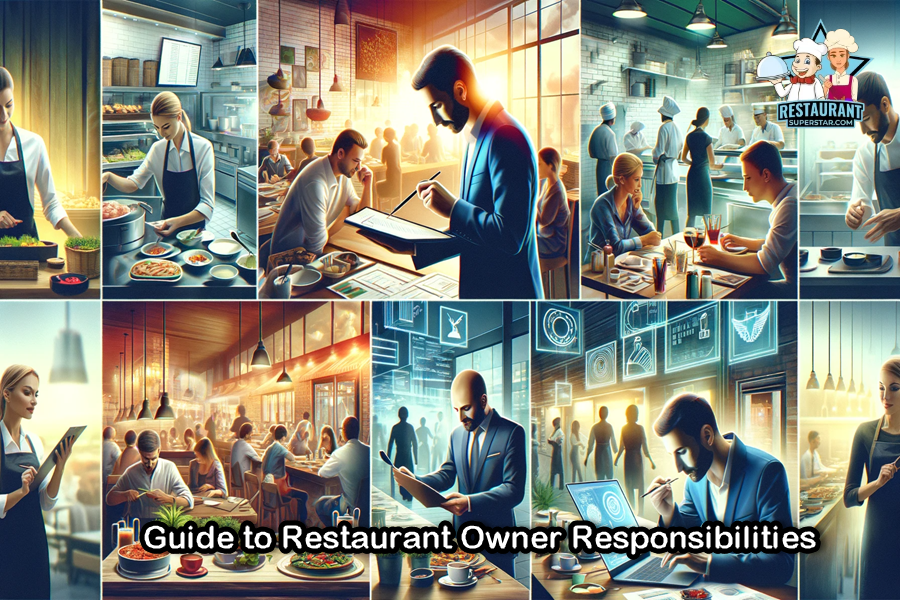Do All Restaurants Have Mice Lurking – Latest Update
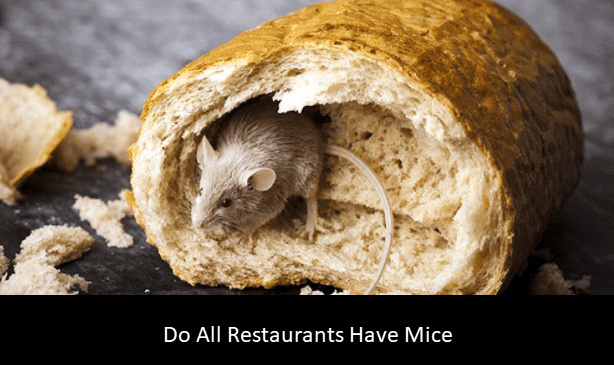
If you’ve ever wondered, “Do all restaurants have mice?” You’re not alone. Many people have pondered this question that delves into food hygiene and safety. Rest assured, we have the answer you’re looking for and are here to enlighten you.
Do All Restaurants Have Mice
Do all restaurants have mice? While not every restaurant attracts mice, it’s no secret that these tiny troublemakers have a soft spot for them. Tempted by abundant food and water, they can threaten cleanliness standards and a restaurant’s reputation. To prevent uninvited guests, maintain spotless kitchens, and eliminate any chance of rodent revelry.
Greetings,
I’m Jeff, your friendly restaurant consultant based in sunny Florida. With extensive experience in the industry, I’ve encountered numerous inquiries throughout the years.
However, one question consistently arises: “Do all restaurants have mice?” This valid concern warrants a transparent response.
Understanding Restaurant Hygiene and the Possibility of Mice Infestations
In my line of work, I’ve seen it all. From gourmet restaurants with sparkling kitchens to less diligent establishments that would make a health inspector cringe.
It’s important to realize that while restaurants can potentially attract mice, not all do.
These pests are opportunistic by nature, and their presence is usually a sign of problems with cleanliness and waste management.
Restaurants are a beacon for mice due to their abundance of food and water. Unsealed containers, spills, and unattended waste can draw in these rodents.
But even so, it doesn’t mean every restaurant teems with these unwelcome guests.
Signs of Mice in a Restaurant
As a restaurant consultant, part of my job is to assess an establishment’s overall cleanliness, including looking for signs of pest activity.
Droppings, chewed wires or packaging, and even nests in secluded spots are common signs of mice. If you ever spot these signs in a restaurant, it’s a definite red flag.
Impact of Mice on a Restaurant’s Reputation
A single rodent sighting in a restaurant can have a devastating impact on its reputation. In today’s digital age, where every customer holds the potential to be a vocal critic, news of a mouse sighting can quickly spread like wildfire, wreaking havoc on the establishment’s standing and credibility.
Additionally, the presence of mice poses serious health risks, as they are known carriers of diseases such as salmonella. This raises major concerns for restaurant owners and puts patrons’ well-being at significant risk.
Maintaining a pest-free environment is paramount for preserving the integrity of a restaurant’s reputation and the safety of its customers.
With all these factors in mind, it’s clear that the question “Do all restaurants have mice?” cannot be answered with a simple yes or no.
The presence of mice in restaurants is largely dependent on the establishment’s hygiene practices, its commitment to pest control, and how effectively it manages waste.
Diving Deeper: Mice Infestation in Restaurants
As we’ve already established, not all restaurants have mice, but many face a challenge due to the environment they provide – food, shelter, and warmth.
However, one crucial factor that can tip the scale either way is the restaurant’s hygiene standards. Here’s a bit more insight into how this works.
Why Restaurants Might Attract Mice
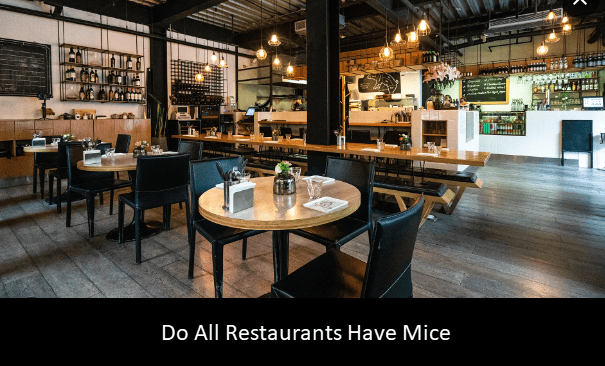
Every restaurant, regardless of its size or popularity, has the potential to attract mice. Why is that? As living creatures, mice seek three fundamental things – food, water, and shelter, all of which a restaurant inadvertently provides.
Imagine a cozy shelter filled with an endless buffet; that’s a five-star hotel for mice.
Additionally, restaurants usually generate heat (from cooking appliances) and have numerous hidden, warm corners (under appliances, behind cabinets); you’ve got a tempting setup for these little critters.
Signs of Mice in a Restaurant
Throughout my years as a restaurant consultant, I’ve developed a sharp eye for spotting the tell-tale signs of a mouse presence.
These signs might be subtle, but they’re pretty clear once you know what to look for. Droppings are usually the first indicator, often found in hidden areas like corners, behind appliances, or under shelves.
Look out for gnaw marks on the packaging or the building structure – mice love to chew on almost everything.
Unusual, musty odors or even the sighting of a mouse (usually during quiet hours) are other signs that could indicate an infestation.
Impact of Mice on a Restaurant’s Reputation
If there’s one thing I’ve learned in my career, a restaurant’s reputation can be fragile. A single mouse sighting can lead to negative reviews, almost instantly damaging a restaurant’s image.
And in the age of social media and online reviews, news like this can spread quickly, causing potentially irreversible harm to the establishment’s reputation.
Moreover, it’s not just about reputation. Mice in a restaurant can lead to severe health inspection penalties or, in extreme cases, even lead to a restaurant being temporarily shut down. I’ve seen this happen, and it’s always a devastating blow for the restaurant’s team.
Overall, cleanliness standards play a pivotal role in whether or not a restaurant might have mice.
While no establishment is completely immune, those that uphold stringent hygiene practices and pest control measures stand a better chance of being mouse-free.
Remember, the presence of mice is less about the nature of the business and more about the management of potential food sources and shelter spots these creatures are attracted to.
Discussion about the Health and Safety Implications
When it comes to restaurants, health and safety are non-negotiable. But when mice enter the scene, they pose a considerable risk.
These rodents are known carriers of various diseases, including salmonella, hantavirus, and leptospirosis, to name a few.
If a mouse has access to a restaurant’s food supply, the risk of contamination is high, and the potential for these diseases to be passed on to customers is a serious concern.
It’s a health inspector’s nightmare, and one of the primary reasons mice infestations in restaurants are treated so seriously.
While these stories might seem alarming, it’s crucial to remember that these are exceptions rather than the norm.
Most restaurants take their commitment to health and safety very seriously, investing in preventative pest control measures and upholding strict cleanliness standards.
These serve as timely reminders of the importance of upholding impeccable hygiene standards. It is crucial not only to prevent mice but also to ensure the health and well-being of customers.
While it may be true that certain restaurants may encounter mice, it is important to note that many establishments do not face this issue.
Furthermore, those that do often take prompt action to address the situation.
The Art of Pest Control in Restaurants
Like cooking a delectable dish, pest control in a restaurant is an art form. It requires a keen eye, meticulous planning, and a proactive approach.
From my years as a restaurant consultant, I can attest that establishments with these practices down to science often manage to keep mice and other pests at bay.
Common and Effective Pest Management Strategies Used in Eateries
When it comes to pest control, prevention is often the best strategy. And there are several methods that restaurants can adopt to keep their establishments mouse-free.
- First off, proper sanitation is crucial. Restaurants must ensure that food waste is promptly disposed of and that all food storage areas are kept clean and tightly sealed. This includes cleaning up spills immediately and thoroughly sanitizing all kitchen areas, particularly those hard-to-reach spots that mice love.
- Next up, it’s all about closing the entry points. Restaurants must diligently seal off all potential entry points, as mice can squeeze through even the smallest openings. This can involve something as simple as installing door sweeps or as complex as a complete building inspection for cracks or holes.
- Many restaurants opt to work with professional pest control services. These experts not only handle active infestations but can also provide routine inspections and preventative treatments. They’re equipped with the knowledge and tools to handle pest issues effectively, including our tiny unwelcome guests, the mice.
Importance of Routine Inspections and Preventive Measures
Routine inspections are the cornerstone of an effective pest control strategy. Think of it like a regular health check-up but for the restaurant.
These inspections can spot signs of a potential infestation early on, making handling easier (and often cheaper).
Preventative measures like regular cleaning schedules, staff training on spotting signs of pests, and maintaining the building’s integrity also play a massive role in keeping mice away.
A restaurant that prioritizes these practices tends to have fewer issues with pests, maintaining a cleaner and safer environment and a better reputation among patrons.
Not All Restaurants are Equal: The Variance in Cleanliness Standards
From my experience, cleanliness is a spectrum in the restaurant world. Some establishments shine like a new penny, while others could use extra elbow grease.
Varying Hygiene and Cleanliness Standards in the Restaurant Industry
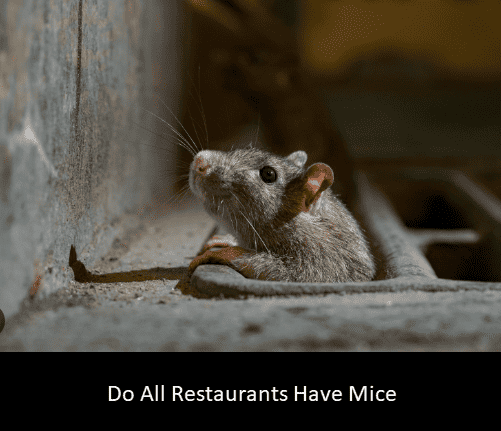
The truth is the restaurant industry has varying degrees of cleanliness. Much of it hinges on management, staff commitment, and, sometimes, the resources available to the establishment.
High-end restaurants often have comprehensive cleaning protocols and dedicated staff to maintain hygiene, while smaller establishments might struggle to keep up due to resource constraints.
However, the size or type of the establishment isn’t always an indicator of cleanliness. I’ve seen tiny diners that are spotless and large, fancy establishments that could use a more rigorous cleaning regime.
The Role of Health Inspections in Restaurants
Health inspections play a vital role in maintaining hygiene standards in restaurants. Inspectors examine various aspects, from food handling and storage to overall cleanliness. They also look for signs of pests, such as our furry adversaries, the mice.
Any restaurant worth its salt knows the value of acing health inspections. They are not just about avoiding penalties but are a matter of public trust.
A high health inspection rating can increase customer confidence and enhance the restaurant’s reputation.
Personal Experiences with Clean Restaurants and Their Preventive Measures
In my career, I’ve had the privilege of working with several restaurants that truly prioritize cleanliness. They go above and beyond to ensure a hygienic environment, extending beyond the dining area and into the kitchen, storage rooms, and waste disposal areas.
One standout experience was with a small family-run Italian restaurant here in Florida.
They took extraordinary steps to maintain cleanliness, such as daily deep-cleaning of the entire restaurant, proper food storage, and even weekly pest control inspections.
Despite being a relatively small establishment, they haven’t had a single issue with mice or other pests.
Another memorable experience was with a popular local seafood restaurant. They invested heavily in staff training to ensure everyone was on board with their rigorous cleaning schedule and pest management protocols.
Their commitment to cleanliness was so intense that they scheduled a pest control service to visit their establishment every month without fail.
So, when you wonder, “Do all restaurants have mice?” remember that many do not, thanks largely to their dedication to cleanliness and proactive pest control.
I believe hygiene is an integral part of the recipe for a successful restaurant. After all, a clean restaurant is a successful restaurant.
Pest Prevention: A Non-Negotiable Aspect of Restaurant Management
An element of the recipe for success for any restaurant lies in maintaining a pest-free environment. Beyond upholding health standards and preserving the establishment’s reputation, this practice ensures the safety and comfort of customers and staff members.
How Restaurants Prevent Mice and Other Pest Issues
From my experience, the most effective way to prevent pests, including mice, in a restaurant setting is through excellent sanitation practices, building maintenance, and professional pest control services.
Good sanitation practices involve proper food storage and waste disposal. To uphold the freshness and cleanliness of food, it is important to store it in durable and airtight containers. Additionally, regular disposal of waste from the premises ensures a hygienic environment.
Cleaning schedules should be adhered to, with special attention paid to hidden areas where pests may reside.
Building maintenance is another critical factor. This includes routine checks for potential entry points and immediate action to seal them. Remember, a hole as small as a dime is enough for a mouse to enter.
Many restaurants also engage in professional pest control services. These experts offer regular inspections, provide recommendations, and carry out preventative treatments to ensure the restaurant stays pest-free.
The Significance of Maintaining a Rodent-Free Environment in a Food Establishment
Keeping a restaurant free of rodents is more than a matter of cleanliness – it’s a matter of public safety.
Mice, as rodents, can carry diseases that pose health risks to employees and customers by contaminating food and surfaces. To safeguard the safety and well-being of all individuals concerned, it is imperative to address this matter promptly.
Moreover, a rodent-free environment also supports the restaurant’s reputation. News of a pest issue can spread quickly, damaging a restaurant’s reputation, sometimes beyond repair.
I’ve been in this industry for years and seen the impressive lengths many establishments go to maintain a clean, safe, and rodent-free environment. And let me tell you, the efforts are worth it.
So, the next time you ask, “Do all restaurants have mice?” remember that while some might, many are committed to rigorous pest prevention strategies to ensure they don’t.
Spotting a Mouse in a Restaurant: What Should You Do?
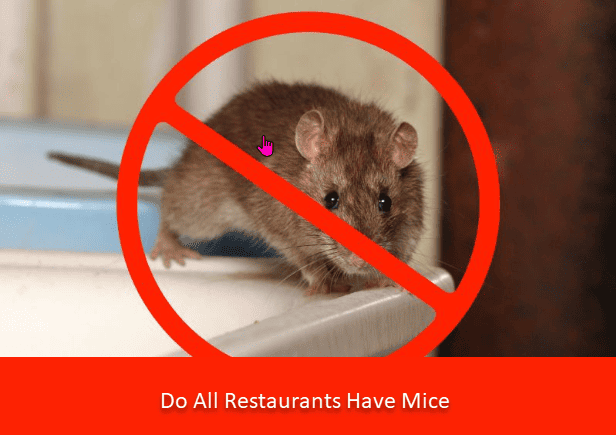
The Restaurant’s Responsibilities in Dealing with Mice Promptly and Professionally
Spotting a mouse in their restaurant is every restaurant owner’s nightmare. It’s a situation that calls for immediate and professional action.
The first step for any restaurant in this situation is acknowledging the problem. Denial or ignoring the issue only leads to more significant problems.
Next, they should contact their pest control service immediately for an emergency visit. In severe cases, the restaurant may need to close briefly for a thorough clean-up and to ensure all pests have been eradicated.
It’s also essential to communicate with customers honestly and transparently. If a customer spots a mouse, the restaurant should apologize and explain the steps to rectify the issue. Many establishments might even offer to comp the meal as a goodwill gesture.
A Reality Check: Do All Restaurants Have Mice?
First and foremost, it’s crucial to emphasize that not all restaurants have mice. It might seem like a grim outlook, given some news stories or personal anecdotes, but it’s not a universal truth.
Many restaurants, especially those committed to high cleanliness and hygiene, work tirelessly to prevent pest infestation, including mice.
From my years of experience in the industry, I can vouch for the incredible efforts that many establishments put into ensuring they maintain a clean, healthy, and mice-free environment.
The daily sweeping and mopping, the routine deep cleans, the regular pest control inspections, and the prompt sealing of any possible entry points – all these tasks are often part of a restaurant’s standard operating procedures.
And it’s all to answer “No” to the question, “Do all restaurants have mice?”
Remember, restaurants are in the business of serving people, and the last thing they want is to jeopardize their customers’ health or reputation.
Maintaining a clean and hygienic environment is in their best interest, not just meeting health regulations but also providing an enjoyable dining experience.
So, let’s shift our perspective. Instead of asking, “Do all restaurants have mice?” let’s acknowledge and appreciate many restaurants’ diligent efforts to prevent pest infestations.
And let’s remember that the establishments committed to these standards are truly worth our time and patronage.
Frequently Asked Questions: Do All Restaurants Have Mice
Here are some common questions that people often ask regarding mice in restaurants. I’ve done my best to provide straightforward and comprehensive answers.
What happens if a mouse is found in a restaurant?
When a mouse is spotted in a restaurant, it can be a cause for concern. Not only does it pose a health risk, but it can also tarnish the restaurant’s reputation. Ideally, the restaurant should immediately contact pest control services to eliminate the problem. Sometimes, a restaurant may be temporarily closed for thorough cleaning and inspection. Health inspectors may also be called to ensure the establishment is safe and hygienic for customers.
How do restaurants control mice?
Restaurants use several strategies to control mice, including regular professional pest control services, maintaining high cleanliness levels, especially in food storage and preparation areas, and sealing any potential entry points that mice could use to gain access. They also implement preventive measures, such as using rodent-proof food containers and ensuring garbage is disposed of correctly.
How do you know if you have mice in your food?
Signs of mice in food can include visible droppings, gnaw marks on food packaging, or the presence of mouse hairs. These signs indicate a pest issue that needs to be addressed immediately.
Are mice usually in the kitchen?
Mice are attracted to places with easily accessible food and shelter, so kitchens are a common area where mice may be found. However, a clean and well-maintained kitchen can deter mice infestation.
Does cooking attract mice?
The smell of cooking can indeed attract mice. As omnivores, mice are drawn to a wide variety of foods. The key is to ensure food is stored correctly and leftovers are cleared promptly to minimize the chances of attracting mice.
Can mice be prevented?
Absolutely. Mice can be prevented through good sanitation practices, storing food in rodent-proof containers, sealing potential entry points, and using professional pest control services for routine inspections and treatments.
What attracts mouse food?
Mice are attracted to various foods, especially grains, seeds, fruits, vegetables, and nuts. They can also be drawn to high-calorie foods like sweets, butter, and meat.
Is it safe to eat food that mice have touched?
No, it is unsafe. Mice can harbor numerous diseases transmitted through saliva, urine, and droppings. Any food suspected of being touched or contaminated by mice should be discarded.
What gets rid of mice the fastest?
Professional pest control services are often the quickest and most effective solution for removing mice. These services employ proven strategies and tools to eliminate mice, such as traps, poison baits, and exclusion techniques.
How do I get rid of mice in my commercial kitchen?
To get rid of mice in a commercial kitchen, maintain strict cleanliness standards, regularly inspect for signs of infestation, and engage a professional pest control service. Seal all potential entry points and ensure all food is stored in rodent-proof containers.
How do I get rid of mice in my business?
The same principles apply to businesses. Good sanitation, professional pest control services, sealing entry points, and correct food storage are vital. Additionally, educating staff on signs of infestation and prevention measures can help keep your business mouse-free.
Conclusion: Wrapping Up Our Journey Down Mouse Lane
Over our discussion, we’ve established that while mice can infest a restaurant due to the abundance of food and shelter, it’s not a given that all restaurants have mice.
Many eateries work diligently to maintain high hygiene and cleanliness standards to prevent pest infestation, including mice.
We’ve delved into the tell-tale signs of a mice infestation, such as droppings and gnaw marks and the detrimental impact an infestation can have on a restaurant’s reputation.
Nobody wants to dine with a side of rodents, right?
In restaurant management, pest control isn’t just an option; it’s a necessity.
We’ve explored effective pest control strategies, routine inspections, and preventive measures that restaurants can use to ensure a clean and safe dining environment.
Moreover, we’ve learned that not all restaurants are equal regarding cleanliness.
Health inspections ensure that eateries adhere to the required health and safety regulations, which diligent restaurant owners take very seriously.
We also discussed what you, as a customer, should do if you ever spot a mouse in a restaurant.
The key takeaway?
Inform the restaurant staff immediately and professionally. It’s a serious issue, and your feedback can help the restaurant address the situation.
Finally, we circled back to our key question, “Do all restaurants have mice?” The answer is a resounding no.
There are many establishments out there, ones that I’ve worked with personally, that go above and beyond to maintain a pest-free environment, ensuring that their diners have a clean, safe, and enjoyable dining experience.
As we wrap up, I want to encourage all of you, as customers, to appreciate and support restaurants that uphold strict cleanliness standards.
These establishments genuinely care about your health, your experience, and the food they serve. Let’s put our support behind them.
Here’s to clean, enjoyable, and pest-free dining experiences.
Jeff Smith is a Restaurant Consultant with over 20 years of hospitality experience ranging from server to owner and general manager. He focuses on Restaurant POS technology as well as restaurant marketing. Check out our world-famous restaurant resources page for a comprehensive offering of hand-picked resources and tools to help your business. You can also check out some of our other restaurant business articles.




